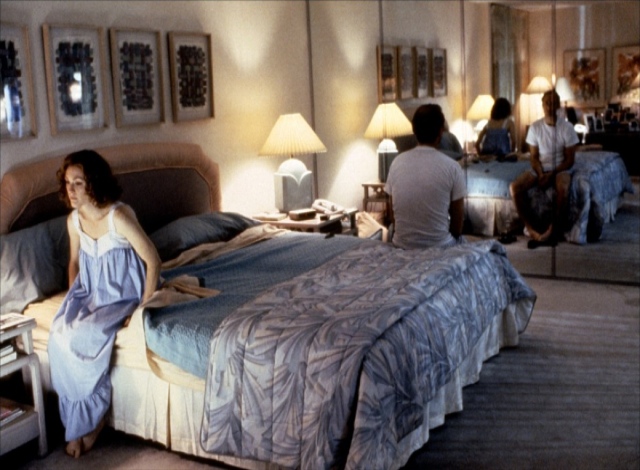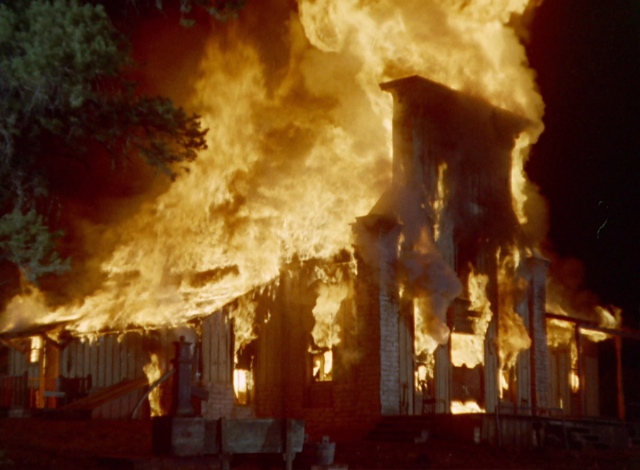
For admirers of Emily Brontë’s 1847 novel Wuthering Heights, Andrea Arnold’s 2011 film adaptation may seem like blasphemy. In a deft auteurist move, Arnold excises all traces of the supernatural that have defined the source text as a masterpiece of gothic literature. This, however, is not a cynical modern update aiming to appease a secular art house; it is a bold innovation from one of cinema’s most invigorating new voices. These radical alterations allow Arnold to explore the same concepts as Brontë, but within the milieu of Arnold’s own established universe, extending her interests from her previous two features, Red Road (2006) and Fish Tank (2009). Like Brontë, Arnold’s work is invested in the haunting power of memory and how two drastically different individuals can forge timeless bonds in a hostile environment. In this new Wuthering Heights, the impetus lies not in souls that are attracted by some unexplainable force, but in the material realities that have shaped Catherine’s (Kaya Scodelario) and Heathcliff’s (James Howson) identities; realities that find their clearest expression in the structure of their home life.
Wuthering Heights is anchored by shots that highlight the physicality of existence. This allows the film’s lean plot to function as scaffolding for a sensual tone poem that documents the presence of corporeal forms within a transient state of nature. Inexpressible feelings and fluid interactions are punctuated by images of windswept hair, earthy textures, and lifeless bodies. The latter form the film’s most obvious motif, manifested as dead birds set against their living counterparts. The soaring creatures may signify any number of things for Catherine and Heathcliff, but it is only their remains—bones, feathers, and dinner ingredients —that they can touch. Through these objects, Wuthering Heights traces the traumas and desires of Catherine and Heathcliff from childhood to adulthood. But this is not a linear film, as Arnold deploys an elliptical editing strategy constructed around their individual memories, establishing a sense of space through their highly subjective relations to empirical experiences and collapsing time along the way. Arnold’s interests seem to lie in how her characters emerge from their own surroundings, without the comforts of a greater binding purpose. Their existence is a tension between that which can be touched and the powerful longings induced by such physicality: a lack of the supernatural is not a lack of mystery. The realism of Wuthering Heights is not a display of certainty in answering its own questions about identity. There is much that remains unexplained and unexplainable.
If there is any pronounced structuring element to Wuthering Heights, it is the houses that populate its indifferent landscape. The space is divided between the shabby Wuthering Heights and the neighbouring Linton family estate. The loose narrative is mostly a mapping of Heathcliff’s movements to and from the Heights. After the opening shot of a drawing of the house—etched onto a wall like a cave painting—the film pulls back to reveal an adult Heathcliff alone in his adopted childhood bedroom. He violently throws his body at the walls. Before we are sure whether he is trying to destroy himself or the house, the film doubles back to a young Heathcliff (Solomon Glave) approaching the Heights for the first time. The film’s conclusion mirrors this movement, with the adult Heathcliff wandering out of the house and into the moors that envelope it, going the way he came. Yet it is the film’s middle that holds the most startling declaration of its thematic linkage between Heathcliff and the dank farmhouse on the moors. In a single cut, Arnold unites his desperate flight from home with his return as a prosperous adult. It is not so much that he has never left, but merely stepped out of the frame so that he could transform. The remainder of the film is divided between the two homes, tracing Catherine’s and Heathcliff’s journeys between them.
Fleeting moments of pleasure and happiness emerge from time to time, but home life is mostly an ongoing chaotic struggle played out against the potential vision of a stable and comforting nest. In Wuthering Heights, the family patriarch, Mr. Earnshaw (Paul Hilton), mumbles vain desires for a happy home as though it were a right that has been unjustly denied to him. He is either unable or unwilling to do anything that would bring his family together. His household is one of resentment, voyeurism, and bitter power plays. Mr. Earnshaw’s uneven and inconsistent distribution of affection and punishment sow the seeds for the house’s downfall. His hopes and disappointments in his children are so muddled together that they foster a thick air of defeatism within the walls of Wuthering Heights. The eldest son Hindley’s (Lee Shaw) chauvinistic domination of his sister Catherine and racism towards Heathcliff play out as desperate attempts to exert power over anything, exploiting the social marginalization of those who don’t share his unearned privilege. Even the more “civilized” Lintons exploit these realities when it is convenient for their immediate desires, banishing Heathcliff in order to “protect” Catherine from him, who is harmed only when the Lintons unleash their dogs on her. These domestic conditions plant the impetus to leave home, and colour how Catherine and Heathcliff are able to enact their individual escapes. Catherine’s social fate is largely determined by the realization that she is a woman living in poverty who can never have total autonomy over her fate. Her decision to marry into the arrogant Linton family is not without its reasons: she trades one master for another, gaining material comfort and stability. But her new world cannot accommodate the inexpressible feelings she has towards Heathcliff, who is not allowed in her marital home. Heathcliff, as a poor black youth, is left with even fewer options. After being sent to sleep in the barn with the animals, he is given the ultimatum by Hindley: either work like a slave, or leave. He chooses the latter.
One of the more consistent elements of Arnold’s work is the notion of trespassing. In her previous films this has taken the form of home invasion and provided a layer of tension, with Red Road’s Jackie (Kate Dickie) sleuthing her way into a tenement building to investigate a mysterious man, and Fish Tank’s Mia (Katie Jarvis) climbing through the window of the suburban home of the man who seduced her before then disappearing. In Wuthering Heights, trespassing is less about narrative stakes and more about mapping out the boundaries of social mobility. When Heathcliff barges into the Linton home there is none of the anticipation of either Red Road or Fish Tank; getting caught is beside the point. Through the reactions to Heathcliff’s and Catherine’s presence inside rooms where they do not belong, invisible limits are brought to light without needless exposition or thematic grandstanding.
A hierarchy is exposed that begins with a patriarchal family order (father is master of the house), but extends to a chain of command that pits rich over poor, man over woman, adult over child, human over animal, and white over black. These lines of demarcation are established and policed by the white men (Mr. Earnshaw, Hindley, and the male Lintons) and they carry with them physical consequences—banishment, brutal violence, and threats of lynching. These boundaries are external but invisible, and no justification for their existence is investigated. The home becomes the forging ground for these structures—it is where they are articulated, practiced, and regulated. They shape the sensual experiences of all the humans isolated in the physical landscape, but cannot contain them, as desires and experiences overpower the invisible fences like an overgrown garden. Catherine and Heathcliff obey these rules when it is advantageous for them to do so, but they are never respected as real. Because these standards are never fully internalized by Heathcliff—nor, to some extent, by Catherine—the lovers inadvertently embody a radical subversion of societal expectations. But this resistance does not facilitate a happy transcendence or the downfall of the social structure. Instead, it places them between an exploitative normalcy and a self-destructive individuality, one that may offer intimate truths, but at a high cost. The suffocation of strictly regulated home life takes no prisoners, leaving a path of death and self-destruction in its wake. Not even Heathcliff’s mysterious wealth—which can buy Wuthering Heights from the poor racist Hindley—can ever make him welcome there.
The social hierarchies in Wuthering Heights are established within the home and radiate outward into the society like a contagion. Yet the film never strays too far out into that larger world. Instead, it remains anchored in the specificity of one single house with a few brief glances through a neighbour’s window. It is about two people’s experiences of their home. The film doesn’t make sweeping statements about how the world functions, and by avoiding this ideological trap it provides a sharper vision into the role home life plays in formulating identity. Wuthering Heights becomes both a microcosm and an anti-microcosm; it represents the larger world around it and yet it represents only itself.




